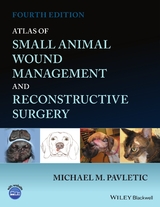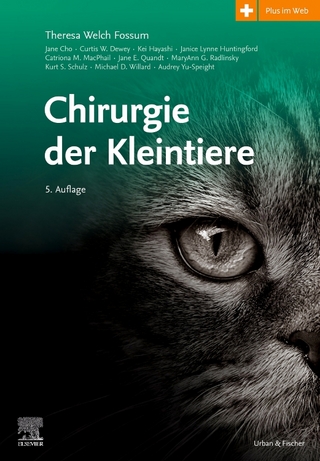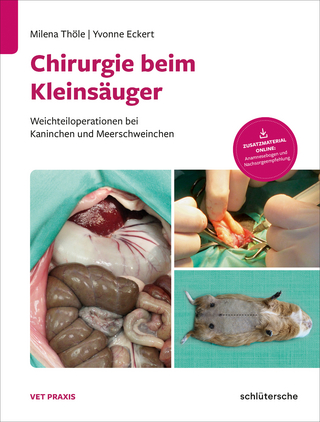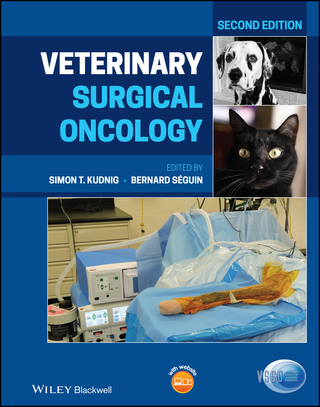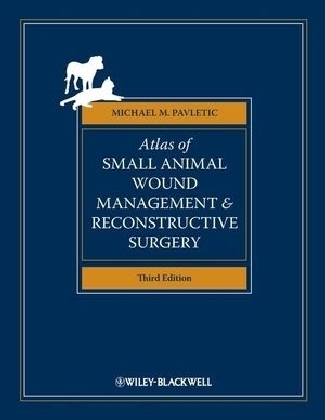
Atlas of Small Animal Wound Management and Reconstructive Surgery
Iowa State University Press (Verlag)
978-0-8138-1124-6 (ISBN)
- Titel ist leider vergriffen;
keine Neuauflage - Artikel merken
Michael M. Pavletic, DVM, Diplomate ACVS, is director of surgical services at Angell Animal Medical Center in Boston, Massachussetts.
Preface.
1. The Skin.
Skin Function.
Skin Structure.
Cutaneous Adnexa.
The Hypodermis.
Cutaneous Circulation.
Congenital Skin Disorders.
2. Basic Principles of Wound Healing.
Introduction.
Wound Healing.
Species Variations in Wound Healing.
Artificial Skin.
3. Basic Principles of Wound Management.
Introduction.
Patient Presentation.
Mechanisms of Injury and Wound Terminology.
Wound classification.
Options for Wound Closure.
Healing by Adnexal Re-epithelialization.
Pointers in Selecting the Proper Closure Technique.
Basic Wound Management in Six Basic Steps.
4. Wound Care Products and Their Use.
Wound Drainage Systems.
Topical Wound Care Products.
Alternative Forms of Wound Therapy.
Concluding Remarks.
Plate 1: Vacuum-Assisted Closure.
5. Dressings, Bandages, External Support, and Protective Devices.
Introduction.
Composition of a Bandage.
Preventing Bandage Displacement.
Tie-over Dressing/Bandage Technique.
Pressure Points: Bandage Options.
Bandage Access Windows .
Bandaging Techniques for Skin Grafts.
Bandaging Techniques for Skin Flaps.
Splints, Casts, Reinforced Bandages
Miscellaneous Protective Devices.
Plate 2: Basic Bandage Application for Extremities.
Plate 3: Tape Stirrups and Padding Dos and Don ts.
Plate 4: Elasticon Bandage Platforms and Saddles.
Plate 5: Spica Bandages/Splints.
Plate 6: Schroeder-Thomas Splint.
Plate 7: Schroeder-Thomas Splint: Security Band Application.
Plate 8: Body Brace.
6. Common Complications in Wound Healing.
Improper Nutritional Support.
Hypovolemia and Anemia.
The Nonhealing Wound: General Considerations.
Failure to Heal by Second Intention.
Scarring and Wound Contracture.
Infection.
Draining Tracts.
Use of Tourniquets for Lower Extremity Procedures.
Seromas.
Hematomas.
Exposed Bone.
Wound Dehiscence.
7. Management of Specific Wounds.
Bite Wounds.
Burns.
Inhalation Injuries.
Chemical Burns.
Electrical Injuries.
Radiation Injuries.
Frostbite.
Projectile Injuries.
Pressure Sores.
Hygroma.
Snakebite.
Brown Recluse Spider Bites.
Porcupine Quills.
Plate 9: Pipe Insulation Protective Device: Elbow.
8. Regional Considerations.
The Canine Profile.
The Feline Profile.
Plate 10: Surgical Technique Menu.
9. Tension Relieving Techniques.
Introduction.
Skin Tension in the Dog and Cat.
Plate 11: Tension Lines.
Plate 12: Effects of Skin Tension on Wound Closure.
Plate 13: Patient Positioning Techniques.
Plate 14: Undermining Skin.
Plate 15: Geometric Patterns to Facilitate Wound Closure.
Plate 16: V-Y Plasty.
Plate 17: Z-Plasty (Option I).
Plate 18: Z-Plasty (Option II).
Plate 19: Multiple Z-Plasties.
Plate 20: Relaxing/Release Incisions.
Plate 21: The Hidden Intradermal Release Incision.
Plate 22: Multiple Release Incisions for Extremity Wounds.
Plate 23: Walking Suture Techniques.
Plate 24: Skin Stretchers to Offset Incisional Tension.
Plate 25: Tension Suture Patterns.
Plate 26: Retention Sutures.
Plate 27: Stent.
Plate 28: Skin Directing for Maximum Coverage.
Plate 29: Relaxing Incision to Reduce Flap Tension.
10. Skin-Stretching Techniques.
Physiology of Skin Stretching.
Presuturing.
Skin Stretchers.
Skin Expanders.
Plate 30: Presuturing Technique.
Plate 31: Application of Skin Stretchers.
Plate 32: Skin-Stretcher Substitution for Presuturing.
Plate 33: Skin Expanders.
11. Local Flaps.
Introduction.
Advancement Flaps.
Rotating (Pivoting) Flaps.
Plate 34: Single Pedicle Advancement Flap.
Plate 35: Bipedicle Advancement Flap.
Plate 36: Transposition Flap (90 degrees).
Plate 37: Transposition Flap (45 degrees).
Plate 38: Interpolation Flap.
Plate 39: Rotation Flap.
Plate 40: Forelimb Fold Flap.
12. Distant Flap Techniques.
Distant Flaps.
Direct Flap.
Indirect Flap.
The Delay Phenomenon.
Plate 41: Direct Flaps: Single-Pedicle (Hinge) Flap.
Plate 42: Direct Flap: Bipedicle (Pouch) Flap.
Plate 43: Indirect Flaps: Delayed Tube Flaps.
13. Axial Pattern Skin Flaps.
Introduction: Axial Pattern Flaps.
Island Arterial Flaps.
Reverse Saphenous Conduit Flap.
Secondary Axial Pattern Flaps.
Plate 44: Four Major Axial Pattern Flaps of the Canine Trunk.
Plate 45: Skin Position and Axial Pattern Flap Development.
Plate 46: Omocervical Axial Pattern Flap.
Plate 47: Thoracodorsal Axial Pattern Flap.
Plate 48: Lateral Thoracic Axial Pattern Flap.
Plate 49: Superficial Brachial Axial Pattern Flap.
Plate 50: Caudal Superficial Epigastric Axial Pattern Flap.
Plate 51: Cranial Superficial Epigastric Axial Pattern Flap.
Plate 52: Deep Circumflex Iliac Axial Pattern Flap: Dorsal Branch.
Plate 53: Deep Circumflex Iliac Axial Pattern Flap: Ventral Branch.
Plate 54: Flank Fold Flap: Hind Limb.
Plate 55: Genicular Axial Pattern Flap.
Plate 56: Reverse Saphenous Conduit Flap.
Plate 57: Caudal Auricular Axial Pattern Flap.
Plate 58: Superficial Temporal Axial Pattern Flap.
Plate 59: Lateral Caudal (Tail) Axial Pattern Flap.
14. Free Grafts.
Free Skin Grafts.
Classification of Free Grafts.
Graft Thickness.
Partial Coverage Grafts.
Dermatomes.
Preservation by Refrigeration.
Intraoperative Considerations.
Bandaging Technique for Skin Grafts.
Plate 60: Punch Grafts.
Plate 61: Pinch Grafts.
Plate 62: Strip Grafts.
Plate 63: Stamp Grafts.
Plate 64: Sheet Grafts.
Plate 65: Dermatome: Split-Thickness Skin Graft Harvesting.
Plate 66: Mesh Grafts (With Expansion Units).
Plate 67: Mesh Grafts (With Scalpel Blades).
15. Facial Reconstruction.
Introduction: Facial Reconstructive Surgery.
Plate 68: Repair Of Lower Labial Avulsion.
Plate 69: Repair of Upper Lip Avulsion.
Plate 70: Wedge Resection Technique.
Plate 71: Rectangular Resection Technique.
Plate 72: Full-Thickness Labial Advancement Technique (Upper Lip).
Plate 73: Full-Thickness Labial Advancement Technique (Lower Lip).
Plate 74: Buccal Rotation Technique.
Plate 75: Lower Labial Lift-Up Technique.
Plate 76: Upper Labial Pull-Down Technique.
Plate 77: Labial/Buccal Reconstruction With Inverse Tubed Skin Flap.
Plate 78: Skin Flap for Upper Labial And Buccal Replacement (Facial Axial Pattern Flap).
Plate 79: Cleft Lip Repair (Primary Cleft, Cheiloschisis, Harelip).
Plate 80: Rostral Labial Pivot Flaps.
Plate 81: Oral Commissure Advancement Technique.
Plate 82: Brachycephalic Facial Fold Correction.
Plate 83: Cheilopexy Technique For Drooling.
16. Myocutaneous Flaps and Muscle Flaps.
Introduction.
Myocutaneous Flaps.
Muscle Flaps.
Plate 84: Latissimus Dorsi Myocutaneous Flap.
Plate 85: Cutaneous Trunci Myocutaneous Flap.
Plate 86: Latissimus Dorsi Muscle Flap.
Plate 87: External Abdominal Oblique Muscle Flap.
Plate 88: Caudal Sartorius Muscle Flap.
Plate 89: Cranial Sartorius Muscle Flap.
Plate 90: Temporalis Muscle Flap.
Plate 91: Transversus Abdominis Muscle Flap.
Plate 92: Semitendinosus Muscle and Myocutaneous Flaps.
Plate 93: Flexor Carpi Ulnaris Muscle Flap.
17. Oral Reconstructive Surgical Techniques.
Introduction.
Plate 94: Mucosal Flaps.
Plate 95: Palatoplasy: Bipedicle Advancement.
Plate 96: Cleft Palate Repair: Mucoperiosteal Flap Technique.
Plate 97: Palatine Mucosal Flap.
Plate 98: Soft Palate/Pharyngeal Mucosal Flaps.
Plate 99: Full-Thickness Labial Closure of Oronasal Fistulas.
Plate 100: Cartilage Grafts for Palate Fistulas.
Plate 101: Angularis Oris Mucosal Flap.
18. Foot Pad Reconstruction.
Introduction.
Pad Laceration and Lesion Excision.
Digital Pad Transfer.
Metacarpal/Metatarsal Pad Transfer.
Accessory Carpal Pad.
Pad Grafting.
Digital Flaps for Wound Closure.
Fusion Podoplasty.
Plate 102: Digital Pad Transfer: Metatarsal/ Metacarpal Pad Defects.
Plate 103: Digital Flap Technique: Major Defects of Digits two or Five.
Plate 104: Digital Pad Transfer.
Plate 105:Metatarsal/Metacarpal Pad Transfer.
Plate 106: Pad Grafting.
Plate 107: Segmental Pad Grafts.
Plate 108: Fusion Podoplasty.
19. Major Eyelid Reconstruction.
Introduction.
The Eyelids.
Plate 109: Lip-to-Lid Procedure.
Plate 110: Oral Mucosal Graft onto Skin Flap.
Plate 111: Third Eyelid Skin Flap Reconstruction of the Lower Eyelid.
20. Nasal Reconstruction Techniques.
Introduction.
Traumatic Wound Management.
Neoplasia.
Neoplasms and Surgical Margins.
Nasal Reconstruction Options.
Plate 112: Septal Coverage Using Cutaneous Advancement Flaps.
Plate 113: Bilateral Sulcus Flap Technique.
Plate 114: Septal Resection Technique.
Plate 115: Alar Fold Flaps.
Plate 116: Musculofascial Island Labial Flap.
Plate 117: Cantilever Suture Technique.
Plate 118: Labial Mucosal Inversion Technique.
21. Cosmetic Closure Techniques.
Cosmetic Considerations.
Causes of Scars.
Minimization of Scarring.
Plate 119: Scar Concealment.
Plate 120: W-Plasty.
Plate 121: Dog Ear: Surgical Correction.
22. Preputial Reconstructive Surgery.
Introduction.
Surgical Conditions.
Surgical Techniques.
Plate 122: Preputial Ostium Enlargement.
Plate 123: Preputial Ostium Reduction.
Plate 124: Preputial Advancement Technique.
Plate 125: Phallopexy.
Plate 126: Urethral Reconstruction for Subanal Hypospadias.
Plate 127: Preputial Urethrostomy Technique.
23. Miscellaneous Reconstructive Surgical Techniques.
Omentum.
Scrotum.
Tail Fold Intertrigo.
Vulvar Fold Pyoderma.
Surgery of the Pinna.
Plate 128: Omental Flap Options.
Plate 129: Scrotal Flap Technique.
Plate 130: Caudectomy for Tail Fold Intertrigo.
Plate 131: Episioplasty.
Plate 132: Flap Options for Pinnal Defects.
Index.
| Verlagsort | Arnes, AI |
|---|---|
| Sprache | englisch |
| Maße | 226 x 282 mm |
| Gewicht | 2200 g |
| Themenwelt | Veterinärmedizin ► Klinische Fächer ► Chirurgie |
| Veterinärmedizin ► Klinische Fächer ► Pathologie | |
| Veterinärmedizin ► Kleintier ► Chirurgie | |
| ISBN-10 | 0-8138-1124-4 / 0813811244 |
| ISBN-13 | 978-0-8138-1124-6 / 9780813811246 |
| Zustand | Neuware |
| Haben Sie eine Frage zum Produkt? |
aus dem Bereich
